What to feed the hens of hens to better rushed? This is a very important issue for poultry farmers. Since each razvodchik perfectly understands that not only the health of the bird, but also its performance depends on the food.
In this article we will discuss the topic of feeding laying hens at home, let's talk about the composition of the feed for them with their own hands. And find out which one is better, chicken feed or feed prepared by yourself.
Table of contents
- What can be fed at home so that the chicken can be carried
- Types of food: what is good for laying
- The composition of some feed for laying hens per 100 g
- What can not be fed
- How to start feeding hens
- What to feed on months for proper care: tips for farmers
- How many times to feed in the summer and winter?
- Age when chickens start to lay eggs and how to increase their number: external signs
- Egg production of various chickens per year and how to increase it
- Feed
- Conclusion
What can be fed at home so that the chicken can be carried
The daily diet for young chickens should be very carefully chosen, if the bird breeder wants to get the maximum number of eggs from each head. To do this, you should take care of the following components, which should be included in the food, the calculation is carried out on one bird.
| Component Name | Mass in grams |
| a piece of chalk | 3 |
| Shell | 5 |
| Salt | 0,5 |
| Additive for egg production | 1 |
| Bone flour | 1 |
| Wheat | 50 |
| Corn | 10 |
| Bran | 20 |
| Barley | 40 |
Also, the bird is fed homemade feed, which are called mash. In addition to the main components, in the form of crushed grain, they add mineral content additives.
To make the chicken more active, experienced breeders know that fresh grass and vegetables should be present in the daily diet. Everything should be crushed as much as possible, which will enable full digestion of food.
In order for the hen to receive the correct amount of calcium, feed rations that are specifically adapted to this category of bird are included in its diet.
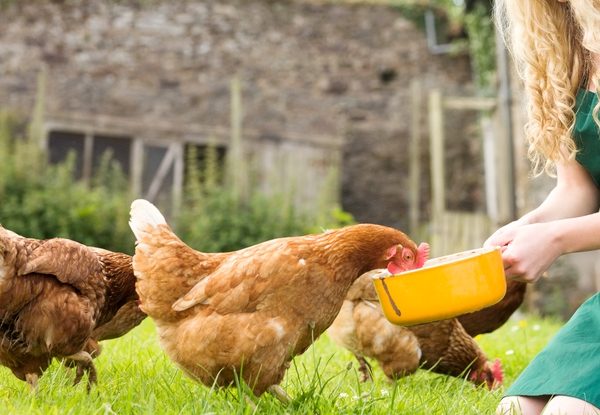
Types of food: what is good for laying
For those who breed a bird, it is very important to remember that a properly selected balance of all vital components will help grow healthy and productive livestock. In this regard, the composition of the daily menu should take into account the presence of the following components.
- Protein. This component helps the full structure of the cells and tissues of chickens. Also in the egg, this substance plays a very important role and is one of the main components. To do this, the diet includes:
• legumes;
• cake;
• earthworms;
• sunflower meal;
• mollusks;
• bone flour;
• fish waste;
• canola;
• soy. - Fat accumulate in the subcutaneous layer and form an energy reserve, which is actively involved in the structure of the egg. To get this important component of a hen, the diet includes:
• oats;
• corn. - Carbohydrates they help to organize the full-fledged work of the whole bird organism; for this, it is recommended to add to food:
• pumpkin;
• potatoes;
• fodder beet;
• carrot;
• whole grain. - Vitamins It is very important for chicken, especially, these are vitamins A, B, D. If there are not enough of them in the diet, then it can cause the body's body soreness, which will negatively affect its egg production. To avoid this, the birds menu includes:
• coniferous flour;
• fish fat;
• green grass;
• silo;
• regular yeast. - Minerals responsible for the structure of the bone corset of the chicken and for the formation of the egg shell. Therefore, in food, birds should add:
• bone meal;
• wood ash;
• a piece of chalk;
• shells crushed;
• gravel;
• lime.
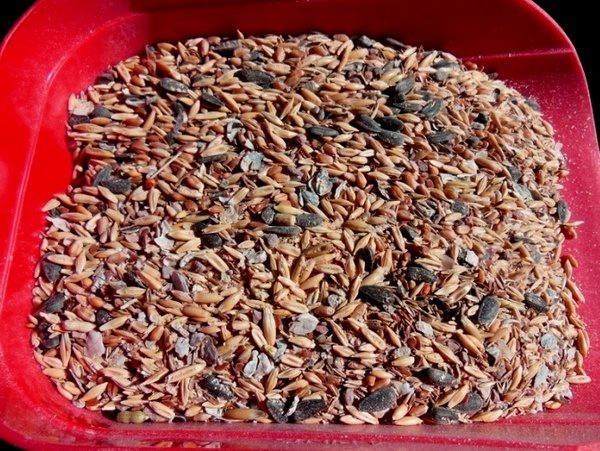
The composition of some feed for laying hens per 100 g
Corn:
- carbohydrate: 66.7;
- proteins: 10.2;
- fat: 5;
- water: 13.9;
- vitamins: PP, A, E, group B, H;
- macro and microelements: manganese, potassium, boron, calcium, chlorine, sulfur, copper, phosphorus, sodium, chromium, selenium, tin, iodine, iron.
Wheat:
- carbohydrate: 56;
- proteins: 12.9;
- fat: 2.6;
- vitamins: group B, PP, C, A, carotene;
- macro and microelements: iron, sodium, phosphorus, potassium, magnesium, calcium.
Barley:
- carbohydrate: 9.5;
- proteins: 12.5;
- fat: 2.5;
- ash: 2.3;
- dietary fiber: 16.9;
- water: 2.4;
- vitamins: group B, K, C, A, E, folic acid;
- macro and microelements: selenium, potassium, iron, magnesium, manganese, phosphorus, sodium, zinc, calcium, copper.
Oats:
- carbohydrate: 6.4;
- proteins: 58;
- fat: 6.4;
- water: 14;
- ash: 3.5;
- vitamins: group B, PP, E;
- macro and microelements: fluorine, potassium, copper, calcium, iodine, molybdenum, manganese, calcium.
Rye:
- carbohydrate: 61;
- proteins: 11;
- Fats: 1.7;
- water: 10.3;
- ash: 1.7;
- fiber food: 14.9;
- vitamins: K, C, group B, A, E, choline, folic acid, niacin;
- macro and microelements: potassium, iron, phosphorus, copper, magnesium, zinc, sodium, selenium, calcium.
Vegetables and root vegetables:
| Name | Carbohydrates
gr. |
Squirrels
gr. |
Fat
gr. |
Water
gr. |
Vitamins | Micro and macro elements |
| Potatoes | 18,5 | 2,3 | 0,6 | 75 | E, PP, B, C | iodine, calcium, potassium, sodium, phosphorus, fluorine |
| Carrot | 9,6 | 1,6 | 0,2 | 90 | PP, B, E, C | calcium, copper, iron, zinc, fluorine, potassium |
| Beet | 11,6 | 1,6 | 0,2 | 85 | B, E, PP, C | iodine, sodium, iron, fluorine, calcium, copper |
| Pumpkin | 6 | 1,1 | 0,2 | 91 | PP, B, C | calcium, iron, iodine, fluorine, potassium |
What can not be fed
There is a certain category of products that should not be given to chickens for food.
- Fresh, white bread or loaf. You can give bread, but it must be dried and ground beforehand, and black stale bread will also do. Fresh bread is very poorly perceived by the hen's stomach.
Before slaughter, the bird can be given mash with white bread. Do it for ten days, in order to meat acquired, a special pleasant taste.
- Salted and fresh fish. Fish is recommended to include in the diet of chickens, but it should not be given very often in salted and raw. Before serving, boil the product as much as possible so that the bones become soft. Before serving, it is mixed with the main feed.
In those days when fish is served, you should definitely increase the amount of water to drink, as this product increases the desire to drink.
- Potato peelings. Potato peel, rather coarse food and therefore it should not be included in the diet of layers. But boiled potatoes are recommended to be given to the bird, this product is very useful and it can be introduced into the feeding process, two weeks after the appearance of the chickens, in the form of wet mash.
- Beetroot. Giving simple beets to chickens is not recommended, due to the fact that it can cause severe diarrhea and lead to cannibalism, due to the possibility of staining in the color of blood. But it can be given in feed form and in the form of tops.
Also not allowed:
- citrus and their peel;
- celandine;
- sweet and salty foods;
- ambrosia;
- Tomato Tomatoes
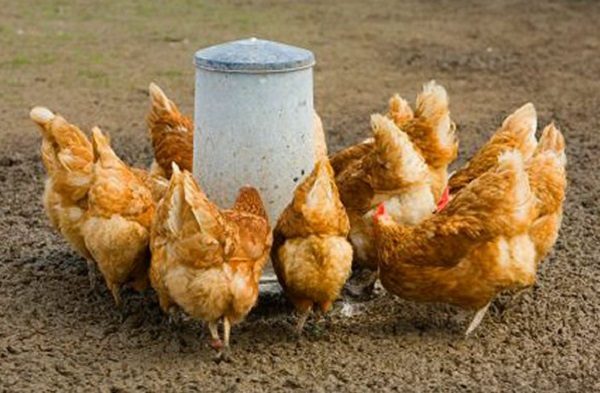
How to start feeding hens
In order for chickens not to lose their egg production all year round, it is very important to feed them correctly and balanced. Feed the bird should receive three times a day:
- the first feeding should consist of a dry mix or grain;
- the second feeding includes wet mash and vitamin formulations;
- The last feeding consists of grain.
The intervals between meals should be the same. During the cold weather mash must be warm.
When chickens begin to moult, they stop well to rush. During this period, it is worthwhile to improve the diet by increasing minerals, especially it is recommended to add sulfur.
You will also be interested to know:
- How to feed chickens from the first days of life?
- 8 types of chicken feedersmade by hand.
- The reasons, why chickens do not rush and what to do with it?
What to feed on months for proper care: tips for farmers
Winter. The cold period of the year is very difficult for the bird, so it is worthwhile at this time to pay special attention to nutrition and the norms of its components:
- grain - 50 grams;
- mash - 30 gr;
- potatoes - 1 medium root vegetable;
- cake - 7 gr;
- nettle and shredded hay - 10 g;
- whey - 100 g;
- shells, chalk - 3 g;
- bone meal - 2 gr;
- salt - 0.5 gr.
In winter, it is necessary to periodically give fodder beets, cabbage, turnips. Especially carefully it is necessary to ensure that the bird does not become fat. Egg production in cold times decreases markedly, but you should not worry about everything recovering with the arrival of warm days and an increase in daylight hours.
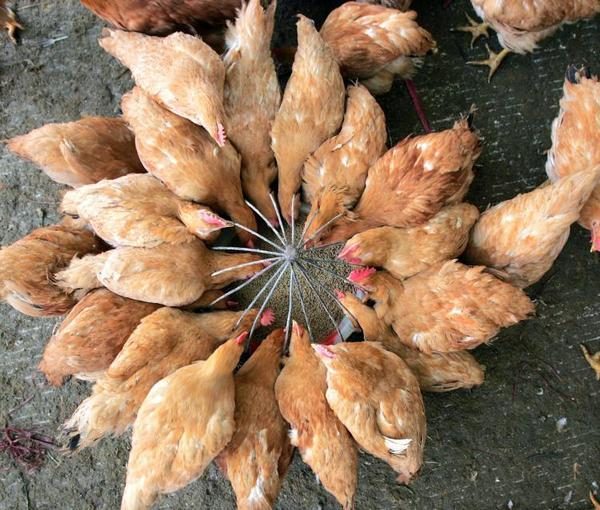
Spring. With the arrival of spring, it is recommended to increase in food green and vitamin-rich food. Back at the beginning of the last month of winter, poultry farmers are recommended to start germinatinggrain that helps restore a deficiency in vitamin E:
- germinated grain - 40 g;
- yeast - 3 g;
- grain - 50 grams;
- straw, hay - 15 gr;
- cake, waste - 15 gr;
- seashells, eggshell - 25 gr;
- bone meal, salt - 3 gr.
Summer. Summer is the most convenient period for feeding birds. At this time, chickens can eat various herbs, insects, worms. It is also very important to give eggshells, which will help increase the egg production of layers:
- grain - 50g;
- bone meal - 1.5 g;
- hay flour with vitamins - 9.5 grams;
- mineral supplements, salt - 6 g;
- flour mixture - 50 g;
- feed on protein - 12.5 grams;
- solid food - 40 gr.
Autumn. During the molting period, it is important to correctly formulate the diet of laying hens, this will help to avoid large losses in egg production, which greatly decreases this season. Autumn is the time when the bird becomes weak and all metabolic processes suffer, therefore each feathered breeder must diversify and properly balance the diet. For this recommend:
- increase the amount of proteins;
- include meat waste and worms;
- more vitaminize feed;
- give more greens, roots and vegetables.
Add to main feed:
- whey, cottage cheese;
- egg shell, well crushed;
- legumes, in the form of greens;
- beet tops and cabbage leaves;
- chalk and shells;
- pumpkin seeds and boiled potatoes;
- sprouted grains;
- yeast.
During molting chickens are recommended to be fed at least three times a day.
- Morning. The bird is offered 1/3 of the norm of grain per day.
- Dinner. Chickens are fed with a special mash, in which minerals and vitamins are added. The norm is calculated so that the hen will eat everything for half an hour.
- Evening. Chickens are fed a simple grain.
Make sure that the bird is not overwhelmed, as this very negatively affects the performance of the chicken.
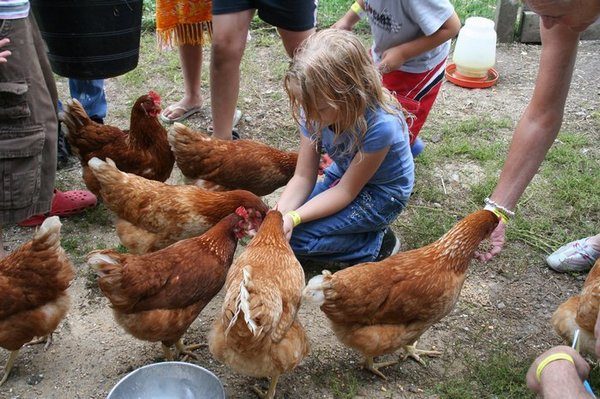
How many times to feed in the summer and winter?
The number of meals for poultry is calculated based on the time of year and individual characteristics. If the chicken is intended for eggs, then it is absolutely impossible to overfeed. Therefore, the supply of food is calculated so that the bird does not zazhirela. Feed is usually given twice a day., it is in positive weather conditions. During molting and the onset of cold weather, feeding is increased to three to four times.
Diet in the table
The table below shows the possible ration for laying hens based onone bird in grams by age.
| Name of feed | 22 - 47 weeks
gr. |
47 weeks or more c. |
| Shell | 5,5 | 5,5 |
| Corn | 42 | ——— |
| Wheat | 22 | 42 |
| Bone flour | 1 | 1 |
| Barley | ————- | 32 |
| Greenery | 32 | 32 |
| Boiled potatoes | 51 | 51 |
| Pumpkin | ————— | 22 |
| Sunflower meal | 12 | 15 |
| Carrot | 11 | ———— |
| Yeast | 1 | 14 |
| Fish and meat waste | 6 | 12 |
| Fish flour | 5 | ———- |
| a piece of chalk | 3,5 | 3,5 |
At week 48, it is recommended to lower the nutritional rate, as egg production noticeably decreases. After a few more weeks, the bird is sent to fight.
How to calculate the norm by weight
How much food to give can be calculated by the weight of the bird, do it as follows. If egg production = 100 eggs. Weight = 1800 grams. Food = 125 grams divided in equal portions per meal per day.
For every extra 100 grams, add 5 grams of feed daily. If the chicken brings 130 eggs, the feed is increased by 5 grams from the norm. At 160 eggs add 10 grams of feed.
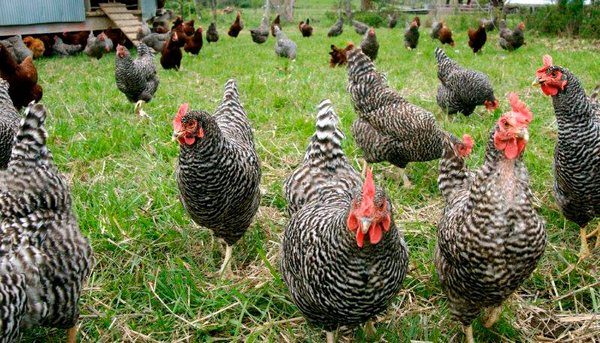
Age when chickens start to lay eggs and how to increase their number: external signs
Now let's talk about external signs when chickens start to lay eggs. Believed to be a chicken starts to carry eggs when its weight reaches 75% of adult birds. Approximately this age comes on 17 - 20 week.
- Small breeds bring the first egg much earlier, than larger meat.
- The appeared bird in February and March ripen faster than May and summer chickens.
- If the hen was born too late, then it can begin to be born only in a year.
- Egg chickens begin to rush from week 17 and do so for ten months without a break.
- The average layer produces about 200 eggs per year.
- The English breed Leggorn is considered to be the most productive, it is her love of domestic poultry farmers who produce chicken for eggs. The norm for this breed is 340 eggs per year, and for especially gifted ones the productivity can be up to 370 pieces.
- Hybrids rush by 2% more, but their descendants do not adopt these qualities, so in this case they recommend pullets to update every 24 months.
- Meat-egg breeds bring up to 170 eggs a year, but their ripening begins with week 22.
- Meat breeds begin laying eggs later than all other chickens, about the eighth month. Their productivity is much lower, but here the eggs are much larger.Rush such breeds no more than seven months. In the year such chickens can produce up to 120 eggs.
- Fight breeds are carried very rarely. and all their eggs are mainly intended for hatching.
Chickens can carry eggs up to fifteen years. But it is worth knowing that every year the number of eggs decreases, which ceases to be of benefit to the breeder, and the old bird does not go for slaughter. Therefore, many try to keep the bird no more than two years.
Egg production of various chickens per year and how to increase it
Factors that affect egg production:
- poultry health;
- lighting;
- breed;
- air temperature;
- age of the chicken;
- nutrition.
To increase the productivity of birds recommended to adhere to the following rules for feeding.
- Meals should be supplied regularly and in equal portions.
- The first meal should be immediately as a hen awakethat is, in the early morning.
- Birds can not be underfed and overfeeding, all this can negatively affect the productivity of the bird.
- The second feeding is carried out for an hour before sleeping chickens.
- The diet should be varied and enriched with vitamins and minerals.
- The quality of food depends on the number of eggs produced, so you should definitely keep a balance between carbohydrates, proteinsvitamins, fats.
- Nutritional value of feed is recommended to maximize in the spring, since at this time the period of incubation begins and it helps to get healthy offspring.
- Very useful in the basic diet include: whole grains, corn, barley, wheat, oats.
It is very important to provide good lighting. It is this factor that can positively affect the productivity of chickens. It is advisable for birds to provide 17 hours of daylight.
The air in the room where the birds are kept should be dry and as warm as possible. In this regard, the coop must be well insulated. In the period of cold weather, you need to take care of the heaters in advance. If the hen freezes over regularly, it will cease to run well.
The most productive breeds include:
| Breed | Start of egg production | Number of eggs
pieces per year |
Additional factors |
| Lohman Brown | from 5 months | 280 | eggs are large, hardy bird |
| Leggorn | from 6 months | 350 | very popular breed |
| Minorca | from 7 months | 180 | eggs are large, but productivity is low, does not like low temperatures |
| Sussex | from 6 months | 230 | with good productivity has tasty meat |
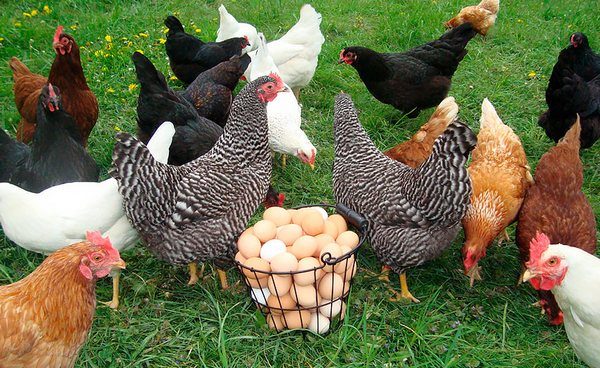
Feed
Compound feed is an important food for poultry, where several components are gathered including minerals and vitamins. Such nutrition is important for proper maintenance and care of the bird.
PC 1: the content of nutrients in the grain for poultry nutrition
This feed contains, as the basis of wheat, corn, barley and bran. Bone meal, which is also part of the feed helps the bird to develop and grow more actively.
| Components | % |
| Premix P1-22 | 1 |
| Shell | 2 |
| Salt | 0,40 |
| Corn | 30 |
| a piece of chalk | 10 |
| Soybean cake | 8 |
| Lysine | 0,10 |
| Sunflower cake | 20 |
| Methionine | 0,05 |
| Bran | 6,2 |
| Monocalc phosphate | 0,8 |
| Indicators | % |
| Sodium | 0,2 |
| Humidity | 12,5 |
| Phosphorus | 0,71 |
| Raw protein | 16 |
| Calcium | 4 |
| Fat fat | 5,5 |
| Threonine | 0,55 |
| Calories | 260 |
| Lysine | 0,75 |
| Cystine methionine | 0,4 |
| Methionine | 0,35 |
How to make at home. On 1 kg take:
- wheat 640 gr;
- meat and bone meal 40 g;
- soda 7 gr;
- salt 1 g;
- sunflower meal 170.5 g;
- premix P1-2; 10 gr.
All mix and add a small amount of normal yeast and sunflower oil to about 20.5 grams.
The composition of the PC 2 for proper feeding
Compound feed PC 2, as well as the previous one, is based on corn and wheat. Also, it adds sunflower oil, fat and fish meal, which helps to increase the productivity of poultry.
| Components | % |
| Premix P-5 | 1 |
| Wheat | 20,3 |
| Methionine | 1 |
| Corn | 37 |
| Lysine | 1 |
| Sunflower cake | 13 |
| Salt | 0,5 |
| Extruded soy | 11 |
| a piece of chalk | 2 |
| Soybean meal | 13 |
| Monocalcium phosphate | 1,5 |
| Fish flour | 1 |
| Indicators | % |
| Sodium | 0,2 |
| Humidity | 13 |
| Phosphorus | 1 |
| Raw fiber | 5 |
| Calcium | 1 |
| Raw protein | 20 |
| Threonine | 0,5 |
| Fat fat | 5,5 |
| Lysine | 1 |
| Calories | 290 |
| Methionine | 0,5 |
| Cystine methionine | 1 |
How to make at home, an approximate calculation for 1 kg:
- wheat 550 g;
- barley 300 gr;
- bran 50 gr;
- sunflower cake 50 gr;
- fish meal 40 gr;
- sunflower oil 20 g;
- shell 50 g;
- salt 3 g;
- chalk 27 gr;
- premix P-5 1 gr.
Mix everything thoroughly and use for feeding layers.
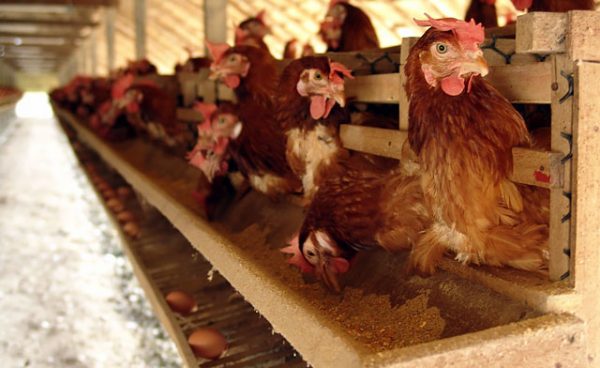
Chicken feed recipes for laying hens and young chickens
Mix the following ingredients:
- corn - 450 gr;
- peas - 70 g;
- barley - 120 gr;
- wheat - 120 g;
- sunflower meal - 70 g;
- Herbal flour - 20 g;
- meat and bone meal - 60 gr;
- fish meal - 60 gr;
- chalk - 20 grams;
- soda - 0.5 tsp;
- salt - 2 tsp.
Connect the following components:
- wheat - 640 g;
- Meat and bone meal - 40 g;
- sunflower oil - 25 g;
- fodder yeast - 25 gr;
- soda - 7 g;
- soda - 1 gr;
- limestone - 75 g;
- sunflower meal - 175 gr;
- Premix P1-2 - 10 gr.
Conclusion
Chicken - a bird that is very popular among poultry farmers. She is unpretentious and has the property, there is everything that she is given, whether it is a waste from the table or special food. It is also very common for razvodchiki to prepare a special mash for them, which it is desirable to feed at one time or be divided by the daily rate. All of these feeding methods, if properly designed and calculated, will help increase the egg production rate of the bird.
Also in the diet you should not forget to add special, necessary for chickens, vitamins, macro and microelements, tops, greens, roots, vegetables.
In order for chickens not to translate food for other purposes, it is not much to fall asleep. If the bird has the opportunity to walk, then the flow of greens can be reduced.
Nutrition is a very important factor in the productivity of the hen, so this issue should be taken very seriously. Below we offer to watch a small video from which you will learn tips on how to feed chickens in summer.

Chickens like "free" life. Every year I release chickens to a plot where potatoes grow — in the spring before planting, in the autumn after harvest. There they go to the grass and the insects are caught, and the chickens dig at the worms. And during these periods, chickens are well carried. At the same time, the plot is fertilized 🙂
It is true that egg production rates largely depend on the conditions in which the hens live and what feeds the hens. Livi cage equipment for laying hens can provide the laying hens with optimal and comfortable conditions in the hen house. Another undoubted advantage of the life of a hen in a cage is the minimization of contact between individuals.